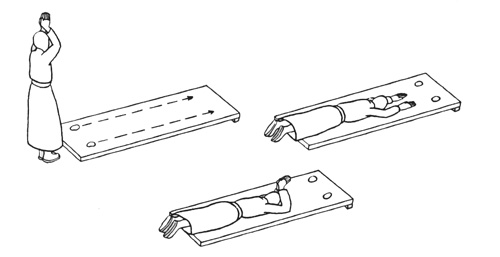The benefits of prostrating are these. The Sutra for Classifying Karma mentions ten benefits—one will have a handsome body, a golden complexion, and so on. Other sutras say that one acquires the merit to become a world emperor for each atom in the ground covered by one’s body. The semi-prostration was discussed in the Tantras; it was how Pandit Naropa used to do his prostrations. Purchog Ngagwang Jampa is supposed to have said, “If you believe in the benefits of making prostrations, you will feel, ‘If only my body, hands, and feet were longer.'”
[Before you prostrate, you join your hands together.] The Tirthikas traditionally press their palms together, but we do not follow this practice: we place our thumbs inside our cupped hands so that our hands are not empty. The shape of our hands then resembles the wish-granting gem.
You then place your cupped hands on your head: this imparts the potential to achieve the crown protrusion. Then place your hands on the space between your eyebrows. This imparts the potential to achieve the urna—the curled hair on the forehead. Then place your hands at your throat to impart the potential to achieve the enlightened speech, a voice with sixty melodious nuances. Then place your hands at your heart to impart the potential to gain the enlightened mind. All these actions both collect merit and purify yourself: they purify the karma and obscurations of your body, speech, and mind.
If you cup your hands when you go down or get off the floor, they say you may be reborn with round animal hooves. You therefore should keep your fingers close together and spread them flat on the ground. Do not make a fist. These actions will help you achieve webs of light between your fingers and toes [one of the marks of the Buddha]. Place your hands and forehead on the ground. Note that a relationship exists between how you get off the floor and how soon you will transcend samsara—so you must get up as quickly as a scurrying fox. Also, if you do not get up soon enough and remain sleepily on the ground, you may be reborn as one of the animal species that go about on their bellies—a reptile, for example. So do not give in to the temptation to have a rest on the floor. If you do not completely straighten your body between prostrations [after you get up], and instead keep your back somewhat bent, you may be reborn as, say, an animal that does not stand upright on its hind legs. So straighten your body. You should not do a large number of hasty prostrations; you should do each of them properly. Je Rinpoche advised us not to just accumulate a huge number of prostrations—doing a hundred thousand as a preliminary practice, and so on; go instead for quality.
Some might claim, “I am going to do my preliminary retreat,” and then take shortcuts when they do prostrations. This is wrong. You must build up your accumulations and purify your obscurations right up until you reach enlightenment. Beginners like ourselves must work hard at accumulation and purification all our lives. Accumulation and self-purification are much more important than meditation: you will not achieve anything at all if you claim, “I have finished my preliminary retreat,” and take things easy thereafter.
If your prostrations are already building up your stock of merit and already purifying your obscurations, you should not worry if you have not yet completed a hundred thousand prostrations. This is illustrated by a story. There were four people in retreat together. One of them had not completed a large number (of prostrations), and the other three asked him what number he had reached. He said, “Have you only been aiming for some large number?” Ideally you ought to complete a large number of prostrations done properly; instead, you keep count of your prostrations so that people can rejoice over your virtue.
You can usually pay homage when you go about your daily routine. When you are walking along a road and happen to see, for example, the symbols of enlightened body, speech, and mind, you should join your hands together. This is a form of homage: they say that if you really know how to practice, you can convert every motion of your body into dharma.
♦
Excerpted from Liberation in the Palm of Your Hand: A Concise Discourse on the Path to Enlightenment, by Pabongka Rinpoche, reprinted with permission from Wisdom Publications. Diagram from The Tantric Mysticism of Tibet by John Blofeld, published by Causeway Books.
Thank you for subscribing to Tricycle! As a nonprofit, we depend on readers like you to keep Buddhist teachings and practices widely available.
